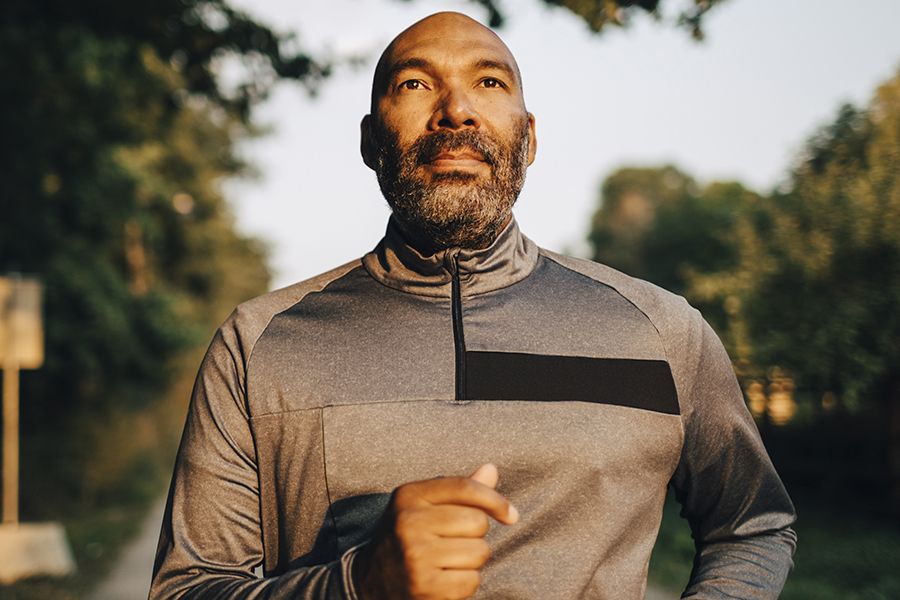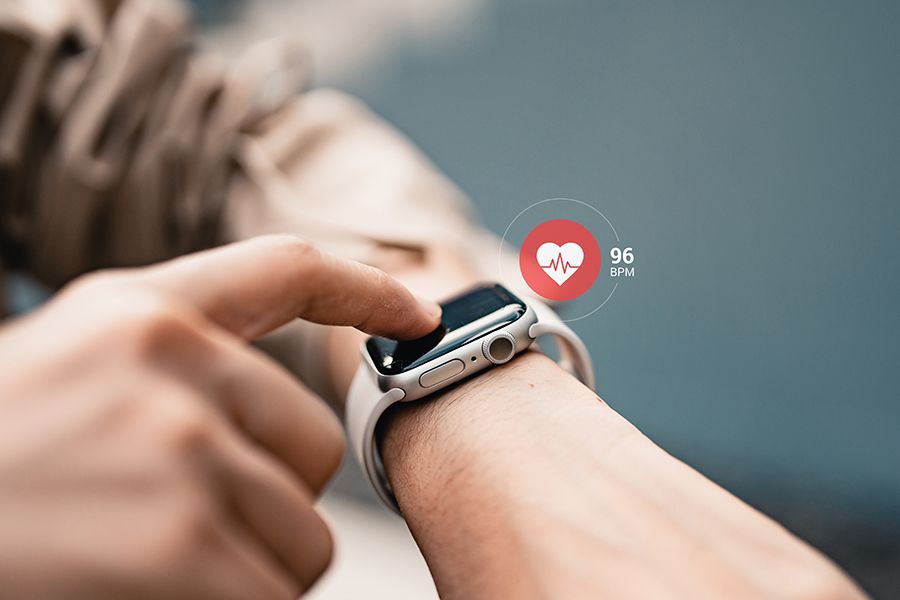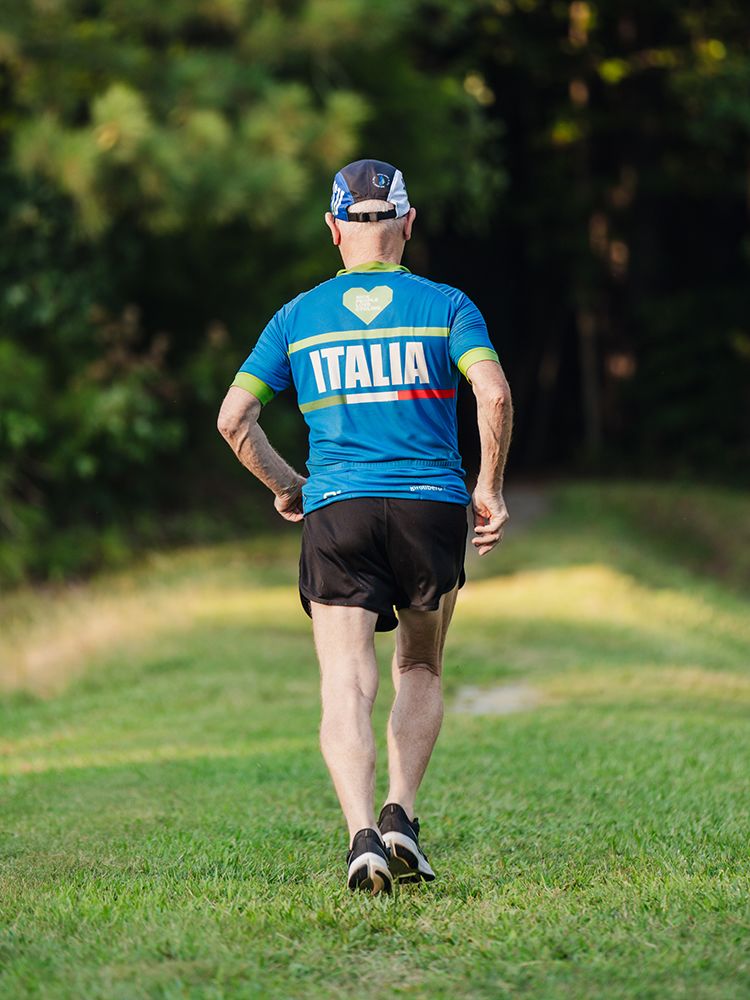Peripheral Artery Disease

When Kevin Thomas Morgan was diagnosed with PAD in 2015, he had no intention of letting it stop him from racing—and today, the 80-year-old athlete is still lacing up and competing in triathlons around the world!
CONTENTS
Health Monitor Living
Peripheral Artery Disease (PAD)
Get the facts on PAD
A peripheral artery disease (PAD) diagnosis can make you worry that life as you know it is over, but don’t worry—with today’s treatment options, odds are you’ll be able to control your symptoms, stay healthy and enjoy your favorite activities for years to come.
The treatments that can help
If you’ve been diagnosed with PAD, there’s good news! Today’s therapies, along with adopting a healthy lifestyle, are helping more people manage their heart disease, lower their risk of heart attack and stroke and slow progression.
Photo by Azul Photography
Photo by Azul Photography
“We’re taking control of our PAD!”
Neither Kevin nor Judith is allowing peripheral artery disease (PAD) to slow them down. Here, they share their top tips for staying on-the-go—whether battling leg pain, fatigue or whatever PAD wants to throw at them. Ask your healthcare team if their tips can help you, too!
Q&A
Answers to your most pressing questions about peripheral artery disease
Walk down your heart risk!
One of the best moves to get your blood flowing and prevent clots? “Walking,” says Ellen Hillegass, PT, PhD, FAPTA. “It causes the circulation in your whole body to improve, but especially in the extremities like your arms and legs.” Want to get started? Ask your healthcare team if this easy-to-follow plan can work for you!
Evaluate your heart health
Take this quiz and share your results with your healthcare provider to find out where you stand—and if you’re doing all you can to protect yourself from heart attack, stroke and other types of heart disease.
Basics
Get the facts on PAD

A peripheral artery disease (PAD) diagnosis can make you worry that life as you know it is over, but don’t worry—with today’s treatment options, odds are you’ll be able to control your symptoms, stay healthy and enjoy your favorite activities for years to come.
First, you might be wondering what PAD even is. Although your limbs are affected, PAD is actually a type of heart disease. It occurs when cholesterol and/or triglycerides build up inside the arteries that bring blood to your extremities, i.e., your arms, hands, legs and feet. Over time, the body views this buildup as a foreign invader, causing an inflammatory response that caps it with a hard, fibrous material. This process is known as atherosclerosis.
_________
How will I know if I have it?
In the beginning stages, PAD may have no symptoms. However, some people may experience pain, cramps, weakness, heaviness or numbness in the affected extremity that occurs with activity and goes away with rest.
If you or your doctor suspect you have PAD, they may first order blood tests to determine underlying causes, such as high blood pressure or high cholesterol.
The most common test used to look for PAD itself is called an ankle-brachial index (ABI) test, which compares blood pressure readings from your ankle and arm.
Why it matters
PAD is a serious health issue that can raise your risk for:
Critical limb ischemia. A severe blockage of blood flow to the limb that leads to pain and non-healing ulcers or sores that damage tissue. In some cases, the affected limb may need to be removed.
Heart attack. The blockage of blood flow to the heart, in the case of PAD by a blood clot that broke off from a blockage in your limb. If left untreated, the heart muscle can be damaged.
Stroke. The blockage of blood flow to the brain, in the case of PAD by a blood clot that broke off from a blockage in your limb. If left untreated, stroke can damage brain cells.
Are you at risk for PAD?
It’s not always known what triggers plaque buildup in the limbs, but certain things can make it more likely to occur:
Non-modifiable risks
- Age (postmenopausal for women and over 45 for men)
- Family history
Modifiable risks
- High blood pressure
- High LDL (bad) cholesterol and low HDL (good) cholesterol
- High triglycerides
- Diabetes
- Smoking
- Excess weight
- Inflammation
- Diet high in cholesterol, saturated fat and trans fat
- Lack of physical activity
Find out where
you stand!
Having regular exams and blood tests can help you keep tabs on your cardiovascular health. Ask your doctor what your numbers are, then review this chart to see if it’s time to rethink your treatment.
|
BLOOD PRESSURE |
||
|---|---|---|
|
Less than 120/80 |
Normal |
|
|
121-129/80 |
Elevated; at risk for high blood pressure |
|
|
130-139/80-89 |
High (stage 1) |
|
|
140-179/90-119 |
Very high (stage 2) |
|
|
180 or higher/ |
Dangerously high; call your doctor or 911 immediately |
|
|
BLOOD SUGAR (fasting blood glucose) |
||
|---|---|---|
|
100-125 mg/dL |
Prediabetes; increases the risk for developing type 2 diabetes, heart disease and stroke |
|
|
126 mg/dL or more |
Type 2 diabetes; greatly increases your risk for heart disease and stroke |
|
|
TOTAL CHOLESTEROL |
||
|---|---|---|
|
Less than 200 mg/dL |
Desirable |
|
|
200-239 mg/dL |
Borderline high |
|
|
240 mg/dL and above |
High |
|
|
LDL CHOLESTEROL |
||
|---|---|---|
|
Less than 100 mg/dL |
Optimal |
|
|
100-129 mg/dL |
Near optimal/above optimal |
|
|
130-159 mg/dL |
Borderline high |
|
|
160-189 mg/dL |
High |
|
|
190 mg/dL and above |
Very high |
|
|
HDL CHOLESTEROL |
||
|---|---|---|
|
Less than 40 mg/dL |
Major heart disease risk factor |
|
|
60 mg/dL and above |
Gives some protection against heart disease |
|
|
TRIGLYCERIDES |
||
|---|---|---|
|
Less than 150 mg/dL |
Normal |
|
|
150-199 mg/dL |
Borderline high |
|
|
200-499 mg/dL |
High |
|
|
500 mg/dL and above |
Very high |
|
Treatment
Understand your options

If you’ve been diagnosed with PAD, there’s good news! Today’s therapies, along with adopting a healthy lifestyle, are helping more people not just manage their heart disease, but also lower their risk of heart attack and stroke and slow progression.
The exact medications, procedures and/or lifestyle recommendations for you will depend on the particular cause(s) of your PAD, as well as your overall health and needs. Discuss the following options with your healthcare provider and work with them to find a plan that can manage your PAD.
Medications that can help
Need to prevent blood clots? The most effective medications for this are blood thinners, such as:
1) Antiplatelets, which work by keeping blood cells from sticking together. Over-the-counter aspirin is a common example, but there are also prescription antiplatelets.
2) Anticoagulants, which work by helping to slow down the blood’s clotting process.
Need to lower cholesterol? Options include statins, ezetimibe, fibrates, PCSK9 inhibitors and bile acid sequestrants.
Need to lower blood pressure? Options include diuretics (water pills), beta blockers, calcium channel blockers, angiotensin-converting enzyme (ACE) inhibitors and angiotensin II receptor blockers (ARBs).
Have type 2 diabetes? Unmanaged blood sugar levels can worsen PAD and increase your risk for heart attack and stroke. Luckily there are several classes of medication available to help you get your numbers to goal and prevent complications, including insulin, non-insulin injectables and oral medications. Some blood sugar-lowering medications, such as certain GLP-1 agonists and SGLT2 inhibitors, have also been proven to help lower your risk for heart disease.
Important! Certain over-the-counter cold medications contain pseudoephedrine, which can narrow blood vessels and worsen PAD symptoms. Ask your healthcare provider about medications or supplements you may need to avoid.
Surgical procedures that restore blood flow
If you have severely narrowed or blocked arteries, you may need one of the following:
• Angioplasty, which opens a blocked or narrowed artery by inflating a tiny balloon inside the blockage.
• Stent implantation, which uses a small mesh tube to keep an artery open after angioplasty.
• Peripheral artery bypass grafting, which uses arteries or veins from other areas to reroute blood flow around narrowed or blocked leg or arm arteries.
• Atherectomy, which uses a special type of catheter to remove plaque buildup from arteries and is most commonly used to treat blockages in the legs.
Lifestyle steps that can help you feel your best
1. Stop smoking. Smoking damages the heart and blood vessels and predisposes people to blood clots, especially when combined with other risk factors.
2. Get quality sleep. Not getting enough shut-eye can increase your risk for high blood pressure. Try aiming for six to eight hours a night.
3. Eat right. A diet that’s low in saturated and trans fat and high in fruits and veggies can lower your heart disease risk by helping you avoid weight gain and keeping your blood pressure, cholesterol and blood sugar levels in check.
4. Increase your physical activity. Moderate exercise comes with many health benefits, including easier weight control, improved blood flow, lower blood pressure, better blood sugar control, stress relief—it’s like an insurance policy for your heart! Ask your healthcare provider which types of activity are right for you—they may recommend cardiac rehabilitation or another type of supervised exercise therapy to reduce PAD symptoms.
5. Maintain a healthy weight. Carrying extra pounds, especially around the waist, can raise your risk for heart disease and diabetes.
6. Avoid or limit alcohol and caffeine. Both beverages can increase blood pressure. Plus, drinking too much alcohol can raise the risk of stroke, heart failure and other cardiovascular problems. Having too much caffeine can lead to heart palpitations and contribute to feelings of stress.



Real-life inspiration
“We’re taking control of our PAD!”

Neither Kevin nor Judith is allowing peripheral artery disease (PAD) to slow them down. Here, they share their top tips for staying on-the-go—whether battling leg pain, fatigue or whatever PAD wants to throw at them. Ask your healthcare team if their tips can help you, too! —by Amy Capetta
“My best advice? Stay in the race!”
____________________
KEVIN THOMAS MORGAN
Chances are you won’t be able to keep up with Kevin Thomas Morgan. Back in 2009, the veterinary pathologist and scientist from Carrboro, NC, ran in the Boston Marathon at the age of 66, followed by six Ironman races, and today can still be found training for either a marathon or triathlon—at the age of 80-years-young. In fact, he recently flew to Finland to take part in the 2023 World Half Ironman Championships.
“I enjoyed a chilly 1.2-mile open water swim, followed by a 56-mile bike ride and a 13.1-mile run,” he says excitedly.
Yet it may be surprising to learn that this lifelong athlete has been living with PAD for nearly nine years. His health journey began in 2014 when he began experiencing foot pain during his marathon training runs. Since, of course, pain comes with the territory when running 20+ miles, at first he wasn’t too concerned and ran through the discomfort.
“But I knew there was something more going on when my Eagleman Half Ironman Race was ruined by foot numbness and right leg calf pain,” he recalls.
“My muscles were not getting enough blood”
Soon after, Kevin had a routine checkup with the “remarkable vascular surgeon Mark A. Farber, MD, whose team saved my life many times” for a previously diagnosed blood vessel condition. He underwent an ankle-brachial index test (which compares the blood pressure at the ankle with the blood pressure at the arm). And this is when the doctor shared the startling news.
“He informed me that I’d developed significant PAD, or peripheral arterial disease, in my right popliteal artery,” states Kevin. PAD occurs when blood vessels in the extremities—in most cases, as with Kevin, in the legs—become narrow or blocked, inhibiting their ability to carry blood to and from the heart.
“The severe calf pain I’d been experiencing, called claudication, was due to the muscles not getting enough blood,” continues Kevin. “My doctor also said with a hint of doom that this disease is progressive.”
Although Kevin was a bit dismayed by the diagnosis, it didn’t come as a shock, either. “I’ve known since my early 30s that I have genetically high fat levels in my blood, also known as dyslipidemia. This is a common cause of atherosclerosis.” Atherosclerosis, which is the buildup of fatty plaque in the arteries, also happens to be a top cause of PAD.
“I was the last runner to cross the finish line”
The promising news was that treatment options for PAD have evolved over the years. Non-surgical methods, such as lifestyle changes, exercise routines and prescription meds (including a blood thinner that can help reduce the risk of further complications in adults diagnosed with PAD) have been shown to manage symptoms and improve artery health.
Kevin was advised to start a walking program comprised of three 30-minute walks per week to encourage the growth of collateral circulation (otherwise known as back-up blood vessels) around his blocked arteries.
“I had another marathon scheduled three weeks later, so I remember thinking, I’ll be doing a bit more than three walks a week!” Kevin participated in the marathon as planned—and was the last runner to cross the finish line. “They were closing the course! And this was the moment I realized I had a lot of work to do to fight PAD.”
“I want to help others regain control of their lives”
After dusting himself off from the marathon, Kevin dug into PAD research and developed a plan for thriving in spite of it. To start, he tested various movement modifications he could make during his runs and other activities to improve blood flow to his feet and ease pain—everything from stretching more and avoiding socks that compress the ankles to choosing sneakers with a wider toe box.
“Using Yoga Toes® toe stretchers dramatically delays the onset of muscle pain when I run and has eliminated foot numbness when I walk,” adds Kevin, who also follows a low-fat, vegetarian lifestyle.
Needless to say, he has not stopped moving forward. In 2022, he ran the North Carolina Half Ironman Race and finished first in his age group, which qualified him for the 2023 World Half Ironman Championship in Finland. He also wrote the book How to Fight The Crippling Pain of Peripheral Arterial Disease (available on Amazon) and won the “PAD Warrior Award For Excellence” from The Way To My Heart, the only non-profit providing free education, high-touch advocacy and real-time support for PAD patients.
His number one goal now? To provide hope to fellow PAD friends by helping them to regain control over their lives. “As you can imagine, I’d like to stay on my feet for as long as possible—and I’d like to help you stay on yours. PAD is serious, so we must be equally serious in our work to manage it. Now let’s get started!”
Kevin’s top tips for staying active
Here, Kevin shares more of the techniques that have been helping him cross every finish line!
Consult a vascular surgeon. During the doctor’s appointment in 2015 when Kevin received the diagnosis, he asked his physician about possible surgical interventions (such as an angioplasty, a balloon to open the arteries, or inserting a stent into the arteries). “He said, ‘Kevin, I could do that, but you need to know that you may lose your leg in the process,’ ” he remembers. “In fact, such cases have been reported recently, which is why I'm so glad Dr. Farber provided the right advice with non-surgical treatments.”
Put one foot in front of the other. Kevin emphasizes the importance of finding ways to stay active and points out that being a marathon runner is not necessary. “It would be best if you employ physical activities that you enjoy, and I strongly recommend a walking program,” he says. “By the way, my PAD has little to no impact on my swimming or cycling, except during steep hill climbs on the bike when I get a little calf tightness.”
Change your mindset. Kevin, who is also a blogger on the site AthleteWithStent.com, admits there are times he feels like giving up (and giving in) to PAD. “The calf pain when I run can be horrible, and I’ll think, ‘Why don’t you just accept your age, have a glass of wine and chill out.’ ” Then he is reminded of a quote from Thai rapper Lalisa Manoba—“Never give up on your dreams, no matter how painful and difficult your journey is”—and explains that the real challenge of living with PAD starts from within. “It’s a journey, not a destination,” he concludes. “I have the joy of running with my two feet and ten toes. Is there pain? Yes, but the good pain—the pain of fighting back. So hang in there and fight back!”
Photo by Azul Photography
Photo by Azul Photography
Photo by Azul Photography
Photo by Azul Photography
Photo by Azul Photography
Photo by Azul Photography
Photo by Azul Photography
Photo by Azul Photography
Photo by Uliana Yurchenko
Photo by Uliana Yurchenko
“Don’t forget about self-care!”
____________________
JUDITH LEE TAYLOR
After living with leg pain for a decade and being told it was due to nerve damage from diabetes, Judith Lee Taylor was finally properly diagnosed with PAD in 2020. “By that point, imaging showed that vessels to both legs were 100% blocked, and unfortunately an angioplasty [a procedure where a balloon catheter is inserted into a blood vessel to open the arteries] didn’t work.”
She then underwent a femoral popliteal bypass surgery (which is also referred to as Fem-Pop), but that didn’t help alleviate her PAD symptoms either. At that point, her surgeon wanted to perform a different type of bypass that could result in disfigurement as a last-resort solution.
Luckily, before that happened, Judith wound up connecting with Kym McNicholas, a journalist and founder of TheWayToMyHeart.org, the only non-profit providing free education, advocacy and real-time support specifically for PAD patients.
“She put me in touch with an interventional radiologist who found a different way to access my clogged arteries via my left heel and finally helped alleviate the blockages.”
Today, Judith takes two medicines to manage her PAD, a blood thinner that helps lessen her risk of heart attack, stroke and amputation; as well as a low-dose aspirin. She shares these other tips for taking control of the condition.
Photo by Uliana Yurchenko
Photo by Uliana Yurchenko
Be proactive. Along with finding the right doctor and medication, Judith recommends taking an active role in your health. “Read, ask questions, exercise and reach out to support groups and organizations to learn from others,” she says. “Your doctors are the experts, but you’re the only one who knows your own body—you’re a part of that heart health team and you’re the only one who can truly advocate for you!”
Pay attention to how your body feels. “Check in with yourself after you receive treatment. If something doesn't feel right, find out why—ask your doctors, look up your symptoms—don’t just live with it,” she says. “Do all you can do and use all the tools available to be as healthy as you can be.”
Make time for self-care. “Sleep is not a luxury; it’s essential for keeping your body happy and healthy, so don’t sacrifice it,” Judith states. “Make the time to enjoy music, pray and meditate, too, since those things can alleviate stress, which can negatively impact your cardiovascular health.”
Do a diet check, too. “The food we eat is how we create and rebuild our bodies, so it’s important to fuel it right,” Judith says. The American Heart Association offers numerous dietary suggestions to boost cardiovascular health, such as choosing whole grain foods, consuming an array of colorful fruits and vegetables, limiting sugar and reducing sodium and saturated fat. “Each of us is irreplaceable and deserves compassionate self-care,” adds Judith. “Take time to renew yourself on all levels.”
Have an attitude of gratitude. Judith, a reverend at the Tyler Unity Center in Tyler, TX, practices positive thinking and is a firm believer in the power of giving thanks. “We are stronger, wiser, more intuitive and more loved than we think,” she says. “It has been scientifically proven that our attitude plays a major part in our health responses.” Judith suggests looking for things to be grateful for, such as the people in your life. “And aren't you glad medicine has advanced so much? Gratitude attracts more to be grateful about. Yes, sometimes I hurt so much that I cry, but every day is a celebration—and a chance to make the world a better place.”
Q&A
Expert answers to your pressing questions about cardiovascular disease

MUST I QUIT SMOKING?
Q: Since being diagnosed with heart disease, I started working out more seriously and eating pretty well, but I still can’t kick my smoking habit. I’ve tried quitting multiple times but always gained a lot of weight, which made me more fatigued with less desire to exercise. Will cigarettes really make a difference if I’m practicing other healthy behaviors?
A: Quitting smoking is nearly always the number one thing you can do to reduce your risk of adverse cardiovascular events. Smoking is a very powerful risk factor for heart disease—not only does it promote the development of plaque in your arteries, but it is also associated with the formation of blood clots that trigger heart attacks and strokes. Please ask your doctor for help with smoking cessation—you don’t need to do this alone!—and, if needed, request referral to a smoking cessation specialist. Several strategies are proven to work, including many types of nicotine replacement therapies and other FDA-approved medications.
CARING FOR LEGS AND FEET WITH PAD
Q: I just learned I have peripheral artery disease and have a higher risk of stroke, blood clots and heart attack, so I started walking and making heart-healthy recipes. But I’m concerned about how to best care for my legs and feet. Do you have any recommendations?
A: One of the best ways to protect your legs and feet is to continue to exercise. A safe exercise program (be sure to clear it with your doctor) can improve blood flow to your legs, protect your muscle tone, improve symptoms and reduce the risk of developing wounds and infection. If your peripheral artery disease is severe, you should inspect your legs and feet every day for small breaks in the skin or emerging infections—these should be identified and treated right away!
WILL I NEED A BLOOD THINNER FOR LIFE?
Q: Over a year ago, I recovered from a stroke due to my underlying peripheral artery disease, and my doctor said I need to take a daily blood thinner to prevent another one. I’m improving my lifestyle, so why do I need to take medication every day and will it be for the foreseeable future?
A: Prevention of recurrent heart attacks and strokes (so-called “secondary prevention”) requires a comprehensive approach, and while that always starts with a good diet and regular exercise, that’s not enough. Thankfully, we now have extraordinary medicines that further lower the risk of future heart attacks and strokes. These medications include those that lower cholesterol, treat high blood pressure and manage diabetes. However, preventing blood clots is also key. Currently, a low dose of a blood thinner or a combination of aspirin with another anti-platelet drug are the best options to discuss with your doctor. No matter which regimen you’re on, it’s generally necessary to continue it as long as your risk of cardiovascular disease remains high.
OUR EXPERT:
Michael J. Blaha, MD, MPH,
Professor of Medicine and Director of Clinical Research at Johns Hopkins Ciccarone Center for the Prevention of Heart Disease
Walk down
your heart risk!
One of the best moves to get your blood flowing and prevent clots? “Walking,” says Ellen Hillegass, PT, PhD, FAPTA. “It causes the circulation in your whole body to improve, but especially extremities like your arms and legs.” Want to get started? Ask your healthcare team if this easy-to-follow plan can work for you!
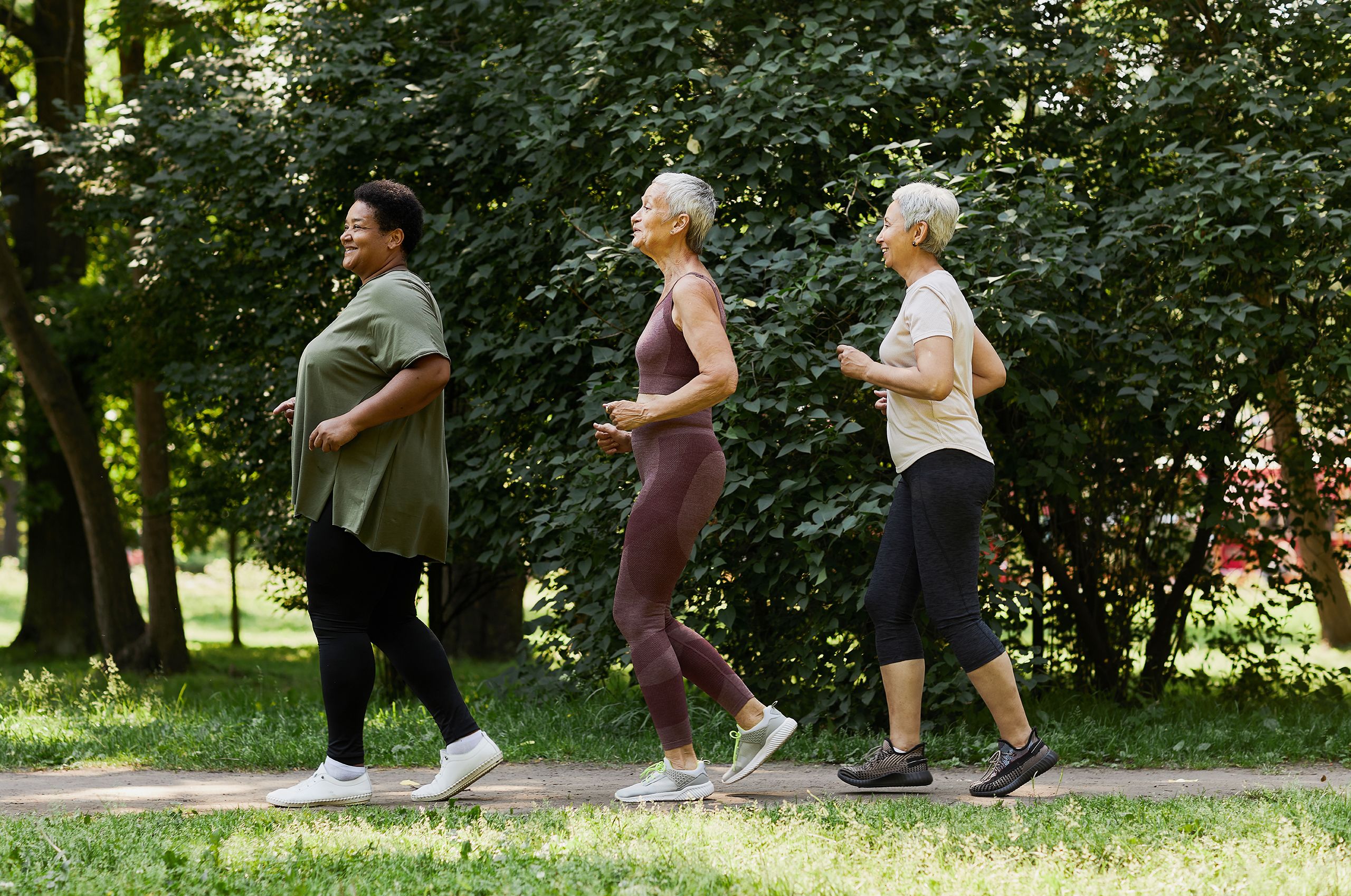
WARM UP
Walk at a slow, leisurely pace for up to 5 minutes. Once your muscles feel warm and your heart rate increases, quicken your pace. During the walk, maintain a pace of 2.5 to 3.5 miles per hour—fast enough to walk a mile in 17-24 minutes.
WEEKS 1 AND 2
YOUR GOAL: Make it a habit
Commit to walking 2-3 days a week at first. Don’t worry about walking for a specific amount of time or distance. What you want is to determine a baseline to build upon. Do this by measuring one of three factors:
HOW LONG: Determine how long you can comfortably walk. You may be able to walk for only 10 or 15 minutes at a time—and that’s enough, for now.
HOW FAR: Measure the distance you can comfortably walk. Can you walk a lap at the local high school track? Can you do more?
HOW MANY STEPS: Use a pedometer to count how many steps you take during an entire day, in addition to your walk. (A 15-minute jaunt is about 2,000 steps). The American Heart Association recommends an average of 10,000 steps a day to boost heart health. Once you know your starting point, you can slowly start to build on it. For the first two weeks, though, just maintain your initial level of activity to help you get into the routine of walking.
WEEKS 3 AND 4
YOUR GOAL: Get stronger, walk longer
Begin to increase the length of each walk in 5-minute increments. Work toward walking at least 30 minutes daily—45-60 minutes is even better. Progress at your own pace.
WEEKS 5 AND 6
YOUR GOAL: Walk today, walk tomorrow
Increase the frequency of your workouts. Add another day of exercise until you’re walking at least 30 minutes most days of the week.
WEEKS 6 AND BEYOND
YOUR GOAL: Beat boredom & stay the course
Congratulations! If you’ve made it this far, you’ve probably made walking part of your daily routine. Chances are, nothing will get in the way of your workout now. You’re committed. But watch out for boredom. To avoid it, try these strategies:
- Make it a social affair. Walking with a friend or club is a great way to stay accountable and pass the time. Look for a local walking group by checking out the bulletin board at your town community center, joining groups for your town on Facebook or visiting MeetUp.com and searching for walking groups near your ZIP code.
- Mix up your route. Free apps like AllTrails and Komoot can help you find new nature paths near you that range in difficulty from easy all the way up to pro, or you can try apps like GPSMyCity and MapMyWalk (also free), which focus on sidewalk-based city routes.
- Go high-tech. If you’re into the numbers game, there are a variety of different options for tracking your calories, heart rate, distance and more each time you go for a walk. Fitness watches include the Amazfit Band 7 ($50), the Fitbit Charge 5 ($150) and the Apple Watch ($399), all of which track steps and other stats. If you’re an iPhone user, your pre-installed Health app can also track your steps (make sure to turn it on in the apps settings!), and for other cellphone users, try downloading free apps like Strava and Runkeeper.
- Create a soundtrack. Download the Spotify app or set up your Apple Music app, both of which let you download and save music—including pre-made motivating workout playlists, or custom ones you make yourself—to take with you. Apps like Couch to 5K can also pair your music with an automated voice coach to inspire you to keep moving while you’re enroute.
- Get captivated by stories. From romance to murder mysteries, nothing makes walking time fly by quite as effectively as listening to a compelling podcast or audiobook. Chances are your local library will let you rent audiobooks for free, or you can sign up for Audible if you don’t want to wait for a popular book to become available. If you’re interested in breaking into the podcast scene, try apps like Pocket Casts, Overcast or Apple and Google also offer their own, then search for topics that interest you, such as true crime, comedy, cooking or history.
- Make it a game. Try walking bingo! To do: download a “neighborhood bingo” card online— myfreebingocards.com has a bunch of options, including ones for the beach or woods if you’re headed that way—then bring the card on your walk and either cross off items as you see them, or snap photos with your cellphone. Keep walking until you’ve hit “bingo!” This can be a fun way to get the kids involved in walks, too.




Challenge yourself!
These methods can boost the health benefits of walking:
- Pump your arms. This increases your heart rate and further improves cardio function.
- Shorten your stride. Walk as if you were on a tightrope. This helps speed up your pace, and it works your glutes and hamstrings, too.
- Change your terrain. If you have good balance, walk on a dirt path or sandy beach. The uneven surface will help develop stronger abdominals and back muscles. Or, for a cardio challenge, try walking an incline without decreasing your speed.
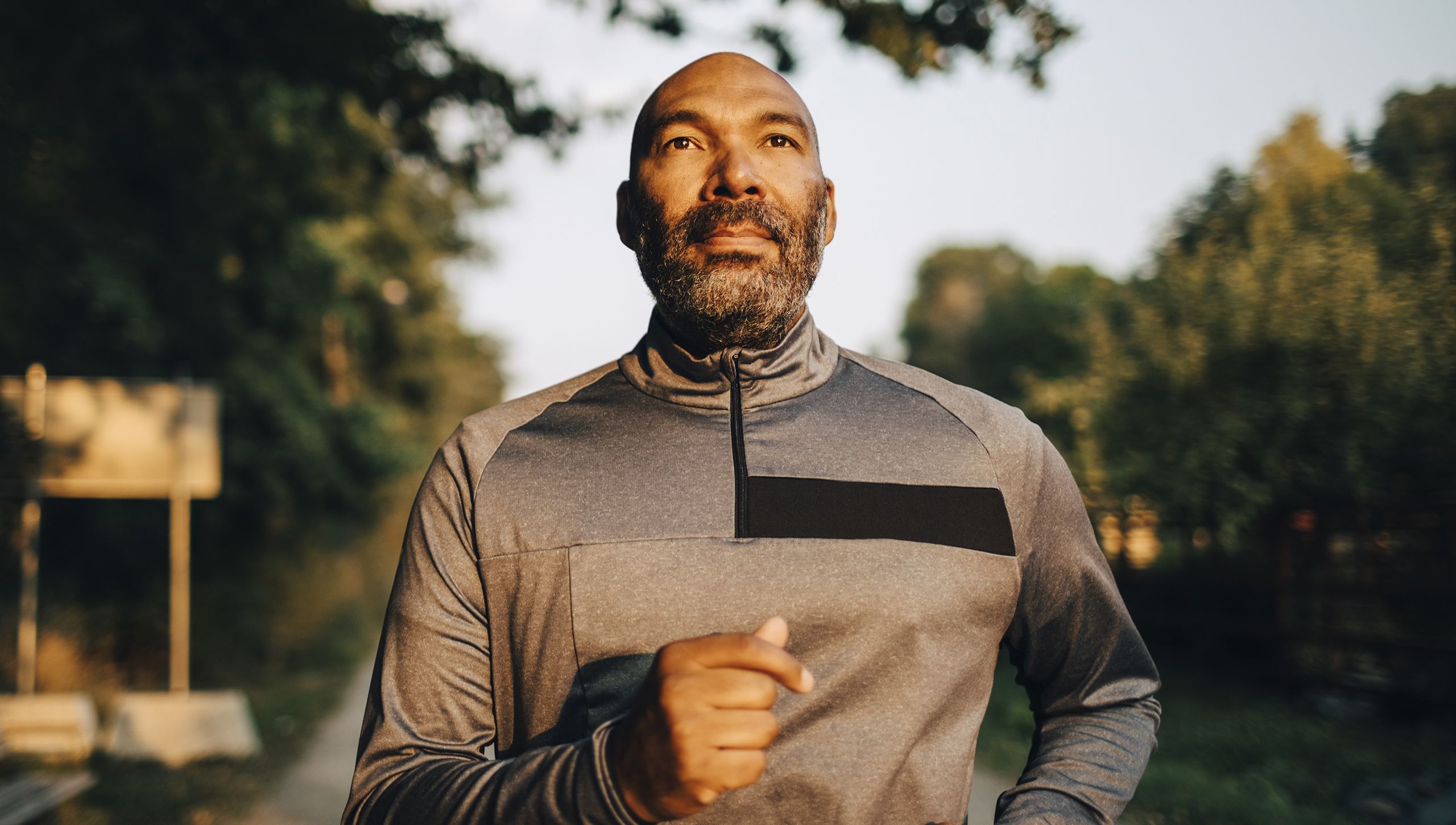
Quiz

Special thanks to our medical reviewer:
Michael J. Blaha, MD, Director of Clinical Research, Ciccarone Center for the Prevention of Cardiovascular Disease; Professor of Medicine; Johns Hopkins
Maria Lissandrello, Senior Vice President, Editor-In-Chief; Lori Murray, Associate Vice President, Executive Editor; Lindsay Bosslett, Associate Vice President, Managing Editor; Joana Mangune, Senior Editor; Marissa Purdy, Associate Editor; Erica Kerber, Vice President, Creative Director; Jennifer Webber, Associate Vice President, Associate Creative Director; Suzanne Augustyn, Art Director; Ashley Pinck, Associate Art Director; Sarah Hartstein, Graphic Designer; Kimberly H. Vivas, Vice President, Production and Project Management; Jennie Macko, Senior Production and Project Manager
Dawn Vezirian, Vice President, Financial Planning and Analysis; Tricia Tuozzo, Sales Account Manager; Augie Caruso, Executive Vice President, Sales & Key Accounts; Keith Sedlak, Executive Vice President, Chief Growth Officer; Howard Halligan, President, Chief Operating Officer; David M. Paragamian, Chief Executive Officer
Health Monitor Network is the nation’s leading multimedia patient-education company, with websites and publications such as Health Monitor®.
For more information: Health Monitor Network, 11 Philips Parkway, Montvale, NJ 07645; 201-391-1911; healthmonitornetwork.com ©2024 Data Centrum Communications, Inc. Questions? Contact us at customerservice@healthmonitor.com
This publication is not intended to provide advice on personal matters, or to substitute for consultation with a physician.
NAJ24-DG-PAD-1RAX
Health Monitor Medical Advisory Board
Michael J. Blaha, MD, Director of Clinical Research, Ciccarone Center for the Prevention of Cardiovascular Disease; Professor of Medicine; Johns Hopkins
Leslie S. Eldeiry, MD, FACE, Clinical Assistant Professor, Part-time, Department of Medicine, Harvard Medical School; Department of Endocrinology, Harvard Vanguard Medical Associates/Atrius Health, Boston, MA; Chair, Diversity, Equity and Inclusion Committee, and Board Member, American Association of Clinical Endocrinology
Angela Golden, DNP, FAANP, Family Nurse Practitoner, former president of the American Association of Nurse Practitioners (AANP)
Mark W. Green, MD, FAAN, Emeritus Director of the Center for Headache and Pain Medicine and Professor of Neurology, Anesthesiology, and Rehabilitation at the Icahn School of Medicine at Mount Sinai
Mark G. Lebwohl, MD, Dean for Clinical Therapeutics, professor and chairman emeritus at Kimberly and Eric J. Waldman Department of Dermatology, Icahn School of Medicine at Mount Sinai, New York
William A. McCann, MD, MBA, Chief Medical Officer, Allergy Partners, Asheville, NC
Mary Jane Minkin, MD, FACOG, Clinical professor in the Department of Obstetrics, Gynecology, and Reproductive Sciences at the Yale University School of Medicine
Rachel Pessah-Pollack, MD, FACE, Clinical Associate Professor, Division of Endocrinology, Diabetes & Metabolism, NYU School of Medicine, NYU Langone Health
Julius M. Wilder, MD, PhD, Assistant Professor of Medicine; Chair, Duke Dept of Medicine Diversity, Equity, Inclusion, and Anti-racism Committee; Vice Chair, Duke Dept of Medicine Minority Retention and Recruitment Committee; Co-Director for the Duke CTSI- Community Engaged Research Initiative





